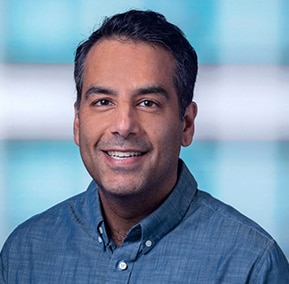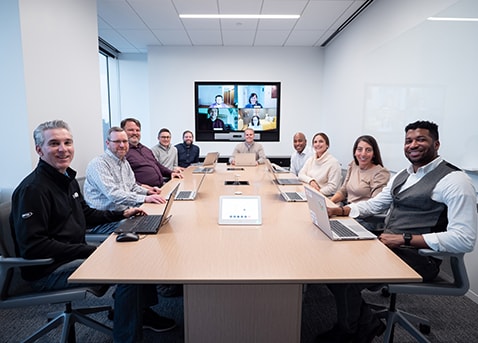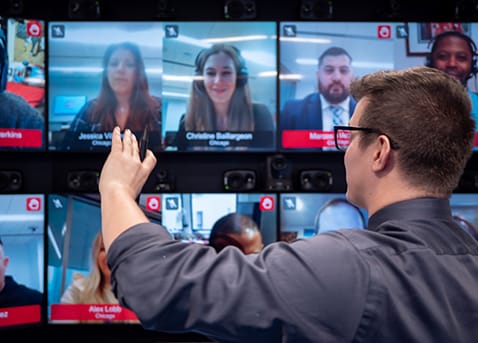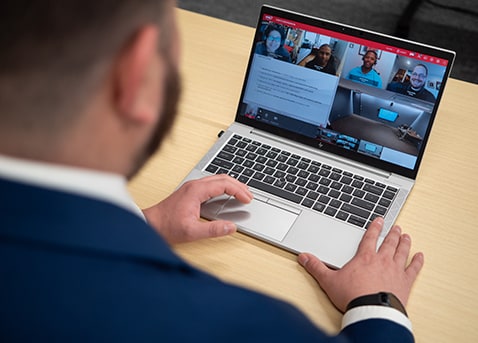March 29, 2024
Prepared for a Bright Future with a Robust Digital Transformation Journey
CDW’s ambitious modernization project not only transformed its technology stack but also empowered team members and streamlined processes.
After guiding countless customers through technology assessments and ensuing changes, CDW turned the lens inward and embarked on its own digital transformation in 2020.
Amid rapid growth driven by acquisitions and a shift toward a services-focused model, the company needed a fresh look at its IT operations.
So began a multiyear digital transformation based on the “people, process and technology” framework that CDW recommends for customers. The journey was significant: the first CTO in the company’s history, a move from data centers to hybrid cloud, enterprisewide standardization of tools and applications, and increased adoption of artificial intelligence.
Most important, CDW’s technology department is now more strategic, better aligned with business objectives, and more robust in efficiency, performance and resiliency. These key takeaways also guide CDW’s work with customers on their digital transformation journeys.
Building a Team to Lead Digital Transformation

Sanjay Sood, CTO, CDW
One of CDW’s first moves was to hire CTO Sanjay Sood in mid-2020. His background is in product development, not IT, an intentional divergence.
“They brought me in to think about the problem differently,” Sood says. “I knew how to build really good teams, empower them and think about these investments from a product perspective, which is that we build and nurture capabilities over time versus just getting projects out the door.”
A series of new hires followed, replacing almost the entire technology leadership team. Two of those hires were Lee Washington, vice president of enterprise infrastructure and applications, and Mike Kennedy, vice president of technology enablement and strategy.
Sood and his team identified three major issues that CDW’s digital transformation needed to address. First, legacy technology made it difficult to scale and optimize performance and resiliency. Reducing complexity was also crucial. Recent acquisitions had led to overlapping systems, and CDW’s business had grown more complex as it expanded beyond product distribution to services. Finally, coworkers spent too much time on manual processes, especially the sales team, which had less time with customers as a result.
The Right Framework Provides a Foundation for Change
Kennedy and his team shored up staffing resources to ensure that progress could continue alongside the business’s day-to-day operations. They implemented the Scaled Agile Framework for Enterprise (SAFe) to manage the portfolio of work so that everyone could follow the same method for how they planned, what they delivered and the timelines they adhered to..
“Given the continuous demands of the business, we knew we needed to create space in the day so we could take on some of this transformational work and start driving the enhancements, knowing that we had the right processes in place,” Kennedy says.
CDW also engaged a third party to conduct an assessment, providing insight into internal perspectives on the company’s technology operations and external benchmarks to help with comparisons with similar companies. “Another independent set of eyes was really helpful to truly understand the road ahead,” Sood says.




35,000
The number of IT service requests that AI assistant Harold can handle in a month
Source: CDW
Strategic Investments in People, Processes and Technology
With the digital transformation underway, Sood was apprehensive about coworkers’ reactions. CDW’s technology workforce has an excellent retention rate, and disrupting it was the last thing he wanted. However, many IT staffers welcomed the change because they recognized the benefits of decreasing technical debt and manual workloads.
“People said, ‘Thank you for investing in the things that I wanted to do for a very long time,’” Sood says. “It was very easy to make them proponents of the transformation rather than detractors.”
Even so, Washington made a point to communicate changes and provide training on new tools and processes. He formed steering committees to represent various departments, enlisting employees to offer input and advocate for change within their teams. CDW also defined more precise functional roles and responsibilities.
Ultimately, CDW increased coworkers across strategic teams by more than 30 percent, lowered the average cost across all labor pools and embraced a hybrid workforce across 23 geographic locations on four continents.
“The big change is that IT has become less of a reactive discussion and much more proactive and strategic.”
— Sanjay Sood, CTO, CDW
From a process standpoint, migrating from ad hoc planning to SAFe set the stage for everything that followed. SAFe uses agile and waterfall methodologies to avoid the strains and delays associated with the project-based model. Retraining more than 430 coworkers in 11 departments was an intensive, 18-month process essential to helping the technology team shift its role.
“Now, we’re able to show efficiencies in how much work we’re able to deliver, the amount of value we’re consistently delivering to the business and how we’re continually managing our cost while driving up performance,” Kennedy says. “That’s how we now celebrate our successes: not just getting work done, but the value we can deliver.”
CDW invested in cloud and consolidated data centers, which improved business continuity and disaster recovery capabilities. It adopted Software as a Service, including Microsoft Teams and other collaboration tools.
Alongside the transition to a hybrid cloud, Washington restructured platform engineering into DevOps, site reliability engineering, major incident and IT service management teams (the latter using ServiceNow for ITSM). Today, those teams support more than 70 enterprise applications. Through automation, proactive monitoring and robust change management processes, they’ve sped up releases and reduced the number of issues by 200 percent. That’s pushed uptime close to 100 percent and enabled faster, better data for business decision-making.
Another significant move was fully digitizing planning and project management in ServiceNow. The goal was to consolidate and standardize globally across three instances: one internally, one for customers and one for federal compliance.
“We invested a lot in the resilience of core technologies that we have and will have for years to come,” Sood says.
Enterprisewide Consistency vs. Localization Benefits
Increasing consistency and reaping the benefits of efficiency, scale and cost were among CDW’s digital transformation goals. The company had developed isolated systems and shadow IT over time, and those discrete systems were an obstacle when installing enterprisewide solutions. Now was CDW’s opportunity to strengthen and consolidate technology.
However, the team wanted to instill consistency without sacrificing the valuable innovation in certain isolated pockets. It also wanted to be mindful of morale and the potential impact of eliminating the tools that people were comfortable with.
To find the right balance, the team settled on a motto: “Start with enterprise and localize where it matters.” The team identified useful localizations that should be rolled up to the enterprise, and it determined where it was worth keeping a variation in place.
That duality takes discipline, because customization costs money, and it’s tempting to localize more than necessary. But for CDW, that balance was worth the effort, allowing the company to achieve standardization while distributing innovations and preserving localizations where appropriate.
Moving into the Future with Artificial Intelligence
CDW’s digital transformation also encompassed an AI strategy. The team established three pillars to guide its AI adoption: off-the-shelf capabilities, tools to customize and integrate into workflows, and more ambitious in-house creations of custom AI models and solutions.
One of the biggest successes has been Harold, an AI assistant that handles repetitive tasks related to IT, HR and other areas. Housed in Teams, Harold handles about 35,000 IT incidents (the equivalent of 11 people on the service desk) and 1,100 HR questions monthly.
“We receive rave reviews about the interactions with him,” Washington says. “People would much prefer to self-serve. That’s also driven productivity up because you’re not waiting in a queue for someone to help you with your ticket.”
Three years after it began, the digital transformation had achieved significant change across CDW’s technology operations. However, because such work is never truly finished, the team put measures in place to maintain momentum and strategic direction.
For example, every month, the team reviews the SAFe product portfolio with CDW’s executive committee, which provides visibility into IT strategy, trade-offs and investment priorities. Outside of normal budget planning, that touchpoint was a new opportunity to bring IT and executive leadership together, Sood says.
“Technology is something that the whole executive team is interested and invested in, so the portfolio is incredibly important to put together, along with agile transformation,” he adds. “The big change is that IT has become less of a reactive discussion and much more proactive and strategic.”
Looking back, Kennedy says three best practices enabled the digital transformation’s success. First, the strategic purpose was clear: The transformation was embedded into the goals of CDW’s corporate strategy. Leadership alignment was also crucial; everyone understood the goals and was committed to the long-term work required. Finally, CDW invested in change management, engaging the coworkers who would create and sustain the change.
For Washington, the initiative was about looking inward to establish processes that would increase innovation and position CDW to provide the best possible support to its customers.
As the technology team has grown more proactive, the rest of the organization has seen those successes and is now more likely to ask for the team’s input. That puts technology right where it should be: at the table, helping to support the bottom line.
“That’s made a difference,” Washington says. “It’s moving from being order-takers to truly being a part of moving the company forward.”
MKT1219
Amy Burroughs
Writer


